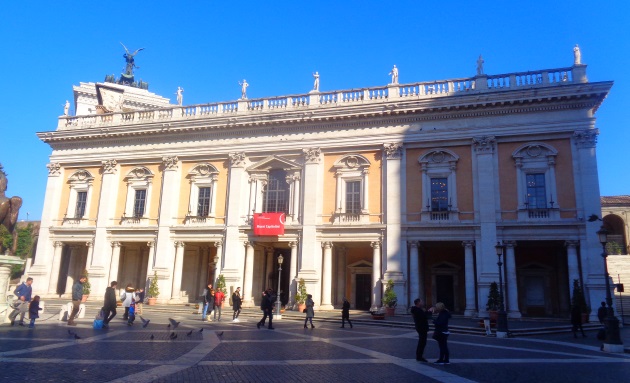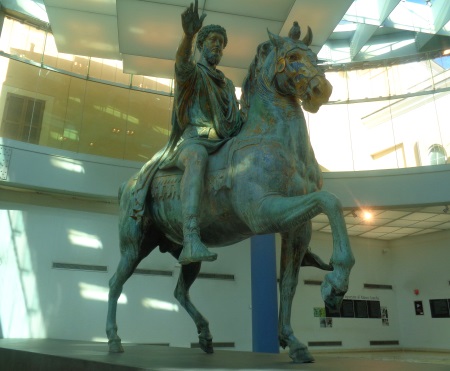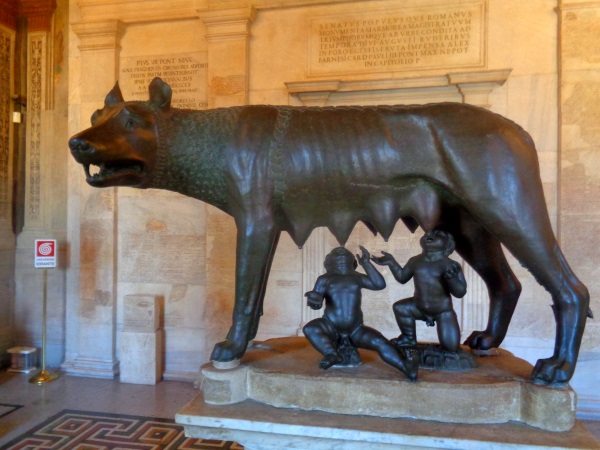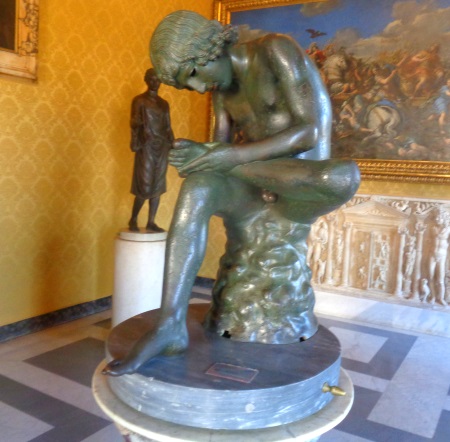The Capitoline Museums (Musei Capitolini) are an association of several museums on the Capitol Hill in Rome. Also the museum name in the Singular, Capitolisches Museum, is used. The Capitol Hill is one of the 7 ancient hills of Rome. The hill with the museum is about 500 meters away from the Colosseum Rome. The main focus in the Capitoline museums is ancient and modern art, especially sculptures. However, there is also a large collection of paintings (Pinakothek) with some world-famous pictures.

The Capitoline Museum is one of the largest and most visited museums in Rome. But above all the Vatican Museum is much better known and largest.
The exhibition was already opened in 1471 by Pope Sixtus IV. The Capitoline Museums are thus considered to be the oldest still existing museum in the world.
Our tip: Buy tickets for Rome online in advanceFor some years now, there have been several large providers of tickets, entrance tickets, tours, etc. for your holiday You can buy entrance tickets for sights online in advance and save yourself queuing at the ticket office. You can also book bus tours, attractions, excursions and much more on the internet. We have picked out two good and reputable providers for you: 1. Getyourguide: Click here for Rome tickets 2. Tiqets: Click here for Rome tickets |
Important exhibits Capitoline Museums Rome
The following is a small overview of the most famous exhibits in the museum on the Capitol Hill in Rome.
Mark Aurel equestrian statue (Italian: Statua equestre di Marco Aurelio)
This is perhaps the most famous exhibit in the Capitoline Museum of Rome. The huge statue, over 4 meters high, dates back to the 2nd century AD. It depicts the Roman emperor Mark Aurel, who lived in this century.

The sculpture with the emperor on horseback was a model for many other equestrian statues in later times. It is one of the most famous bronze sculptures in the world and probably also the largest exhibit in the museum on the Capitol Hill in Rome.
>> Our article Mark Aurel Equestrian Statue
Capitoline Wolf (Italian: Lupa capitolina)
Also a world-famous work of art. Almost everyone has seen it in some context. According to a myth, Rome was founded by the twins Romulus and Remus. The two boys are said to have been abandoned when they were babies and to have been suckled by a she-wolf. This is the work of art Capitoline Wolf.

The figure of the Capitoline she-wolf is extremely old, probably from the 5th century BC. However, the two boys were added later after investigations, about in the 15th century.
>> Our article Capitoline She-Wolf
Our 3 articles about the Capitoline Museum:
The Capitoline Museum all information for visitors and an overview
Marcus Aurelius equestrian statue
Boy with Thorn (Italian Spinario)
Also an antique work of art, about from the 1st century before Christ. It depicts a boy pulling a thorn out of his foot (bronze, height 73 cm).2

The antique Boy with Thorn was later adopted by many artists, also in the Renaissance, as a motif for sculptures.
General Information Capitoline Museums
The museum is divided into several buildings. The two main buildings have been connected by an underground passage for some time. Thus, you do not have to leave the museum if you change the buildings. You simply go into the cellar of one building and walks along the long corridor that ends in the other main building of the Capitoline Museum. The two buildings are the Conservator’s Palace and Palazzo Nuovo. Now all parts of the museums are accessible through an entrance. The entrance is in the Conservator’s Palace.
Madame Tussauds Tickets here.
Pope Pius iV donated many antique works of art from the Vatican Museums to the city of Rome in the 15th century. The city of Rome opened an exhibition on the Capitol Hill in 1471, the first museum in the world.
Besides the above mentioned famous sculptures, there are also famous paintings in the Pinakothek (Picture Gallery) of the Capitoline Museums. These should not be missed, there are among others pictures of Rubens, Caravaggio and Titian to see.
There are also other exhibitions in the museum on the Roman capitol hill like a great coin collection.
Our tip: Buy tickets for Rome online beforehandFor several years there have been several large providers of tickets, entrance tickets, tours, etc. for vacation. You can buy tickets for sights online in advance and save yourself the hassle of queuing at the checkout. You can also book bus tours, attractions, excursions and much more in the comfort of your own home in German on the Internet. We have picked out three good and reputable providers for you: 1. Getyourguide: Click here for Rome tickets 2. Tiqets: Click here for Rome tickets |
Admission Prices Capitoline Museums
The normal entrance fee is 15 Euro. Children under 6 years can enter the museum free of charge. There is also a discount of 13 Euro.
We find that the entrance fees to the Capitoline Museums are relatively high. But as you get to see a lot of world-famous things and it is a big museum, the price is somehow justified.
Tip: Food Tour through RomeIf you are interested in eating and drinking in Rome, you can book a great tour. Meeting point is at Campo di Fiori, then it goes with a great guide 4 hours through the city. It’s about wine, salami, cheese, fish, pizza, ice cream and much more. Hardly any city tour receives better ratings on the Internet. |
Opening Hours Capitoline Museums
The museum is open almost every day of the year. The opening hours are from 9:30 to 19:30.
Exceptions: The museum is closed only on the 3 most important holidays in Italy: New Year, May 1st and Christmas Day. On Christmas Eve and New Year’s Eve the Capitoline Museum closes at 2 pm. On all other days in the year 9:30 to 19:30.
>>> Opening hours Museums Rome
Directions to the Capitoline Museum
There is no direct underground station in the immediate vicinity. We took the Metro Rome to the Colosseum and from there we walked up to the Capitol Hill (about 15 minutes). Of course there are many bus lines in the immediate vicinity:
In the immediate vicinity is also the interesting, gigantic monument Vittorio Emanuele, one of the largest monuments in the world.
The Colosseum and the Forum Romanum are also close by. After the museum you can also visit the Tiber Island and the Circus Maximus Rome. One is in the Capitoline museums in the middle of the center of the ancient Rome.
Youtube-Video (5 min) about the Capitoline Museum (english)
Some foreign words around the museum
Italian Capitoline Museum: Musei Capitolini
Italian Capitol Hill: Campidoglio
Rider statue Marc Aurel italian: Statua equestre di Marco Aurelio
Capitoline Wolf Italian: Lupa Capitolina
Equestrian Statue of Marcus Aurelius English: Equestrian Statue of Marcus Aurelius
Capitoline Hill English: Capitoline Hill
Capitoline Wolf English: Capitoline Wolf
Capitoline Museum English: Capitoline Museums
Capitoline Museums Top 10
The Capitoline Museums are one of the oldest museums in the world and are located in Rome, Italy. They are housed in two palaces on the Capitoline Hill, the Palazzo dei Conservatori and the Palazzo Nuovo. The museum houses an extensive collection of art, artefacts and sculptures from over 3,000 years of history. Here are 10 must-see exhibits at the Capitoline Museums:
The Capitoline She-Wolf:
The bronze statue of a she-wolf suckling Romulus and Remus, the mythical founders of Rome, is one of the city’s most famous symbols.
Equestrian statue of Marcus Aurelius:
A masterpiece of Roman sculpture, this bronze statue depicts Emperor Marcus Aurelius on horseback.
Concrete bust:
This bust is considered one of the finest examples of Roman portraiture and dates back to the 2nd century B.C.
Spinario:
This bronze statue of a boy removing a thorn from his leg is one of the most famous works of Roman art.
The colossal head of Constantine:
This monumental marble head from the 4th century AD is an impressive representation of the Roman Emperor Constantine the Great.
Dying Gaul:
A masterpiece of Hellenistic art, this marble sculpture depicts the last wounded Gallic warrior.
Venus of Capitol:
One of the finest examples of ancient Roman sculpture, this marble statue depicts the goddess Venus as the goddess of love and beauty.
Equestrian Statue of Emperor Antoninus Pius:
This bronze statue depicts the emperor on horseback and is considered one of the finest examples of ancient Roman sculpture.
Statue of Hercules:
One of the largest sculptures of ancient Rome, this bronze statue depicts the mythical hero Hercules.
Seated Boxer:
This bronze statue depicts a seated boxer and is considered one of the most important examples of ancient Roman sculpture.
These are just some of the highlights of the Capitoline Museums. With an extensive collection of art and artefacts, this museum is a must-see for anyone interested in Roman history and culture.